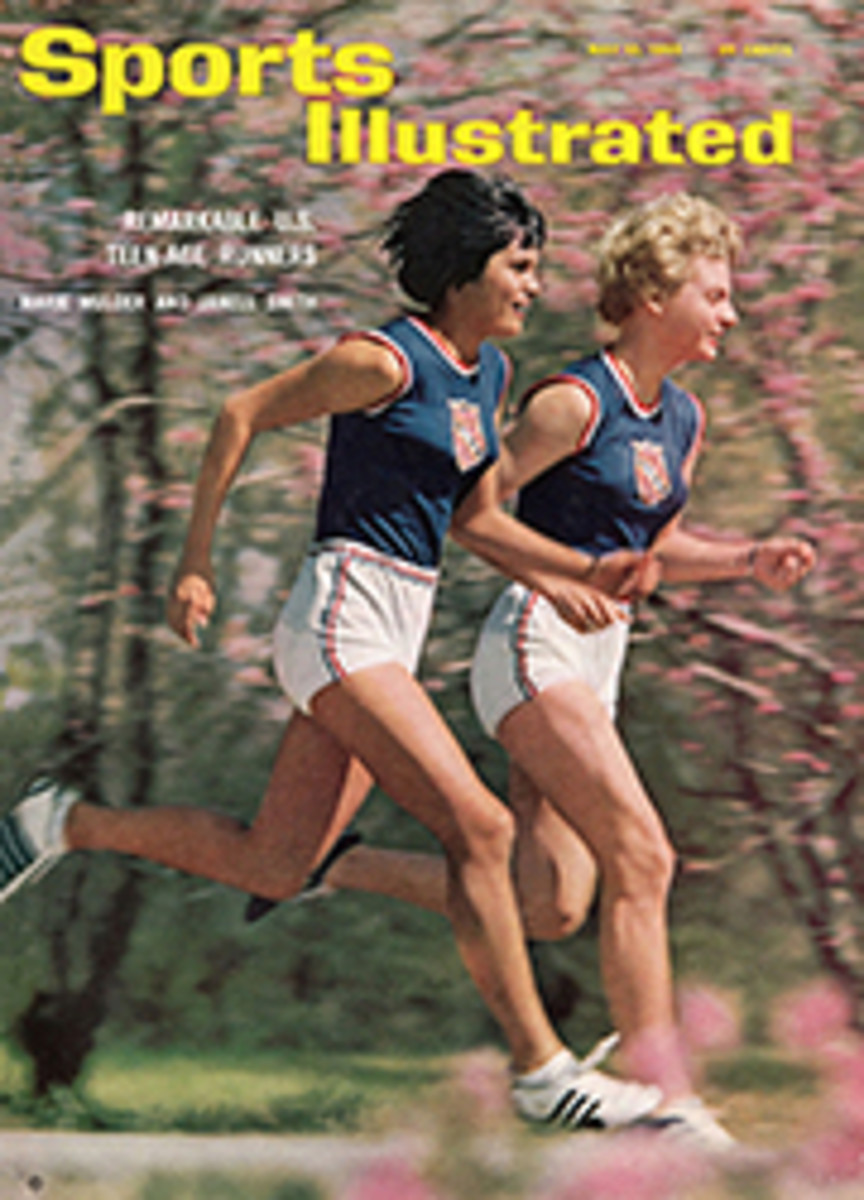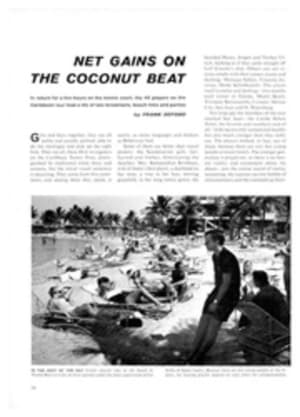
DEADLY SLIDE FOR THE DODGERS
When the Dodgers play in Dodger Stadium on a Saturday night it is more than a baseball game. It is a gala. More horns are tooted and more people shout "Cha-a-arge." More oohs are oohed when somebody hits a big-league pop-up and almost anything is good for a communal laugh.
Last Saturday night a folk giggle arose in the fourth inning from the Ladies' Night crowd of 55,312. San Francisco Giants' Pitcher Gaylord Perry, covering first on a grounder, was not quite to the bag when he took the throw from First Baseman Orlando Cepeda, and he had to stretch his long leg awkwardly to put a toe on the base and retire Ron Fairly. It was funny, but then Perry suddenly started running toward second base and the giggling stopped. Now there was a slightly stunned silence, which is never heard in Dodger Stadium when the Dodgers are playing on Saturday night.
Perry was running toward the supine body of Tommy Davis, which was wiggling just a bit as it lay two feet to the right-field side of the bag. Perry ran up and tagged Davis with the ball, and Umpire Al Barlick—reluctantly, it seemed—raised his thumb a little. It was a double play. You score it 3-1-1, and you mark Tommy Davis absent for three months.
It was moot whether Davis' spikes caught in the dirt or whether they hit the bag as he slid. His right ankle was fractured and dislocated. The doctor said he wasn't in much pain while he waited for the ambulance. The Dodgers were. Their two-time National League batting champion had seemed to be emerging from the dismal slump that had gripped him all last season, and now he was gone.
None of the beardless boys on the Dodger bench could replace Tommy Davis—even a slumping Tommy Davis—and 35-year-old Wally Moon had taken a back seat to the youth movement too long ago to be that much help. The Dodger attack, which had figured to be impotent, seemed now to be virtually nonexistent, and the great experiment was over when it barely had begun.
The question was (SI, March 29): could the Dodgers win a 1965 pennant with a 1915 team? In our time of the tape measure, could a conventionally armed band of guerrillas silently steal the thunder from the overkill artillery that has become baseball's ultimate weapon?
Probably not. As the season dawned, the Los Angeles battle plan appeared ridiculously simple, or maybe just ridiculous. In the era of the lively ball they were reverting to the era of the lively player, compensating for their lack of hitting power by de-emphasizing hitting. With inordinate speed, possibly great pitching and adequate fielding, the Dodgers were drawing up their wagons in a circle to make their best offense a good defense, resolutely ignoring the fact that some renegade had been selling bazookas to the Indians. It was a brave thing to do, and pitiful, like people throwing rocks at armored tanks.
But the month became May and there they were, bobbing and weaving along at the top of the National League. Last weekend, when the Giants came to town, the Dodgers beat them three games out of four. In its first 134 innings the Los Angeles pitching staff had a collective earned run average of 2.08, accomplished almost wholly by the four starters (Sandy Koufax, Don Drysdale, Johnny Podres and Claude Osteen). Koufax, his career threatened with extinction at the end of spring training because of an arthritic elbow, had come back strongly and had a 2-1 record. Drysdale, the workhorse, was 3-2. Osteen, the refugee from the Washington Senators, had a 1.67 ERA. Podres, who pitched only three innings all last year, was 1-0 and had pitched well in two starts. "Never nothing like it," said Coach Jim Gilliam, who played in the league 12 seasons. "I seen teams with two pitchers like them, maybe three. But not four." Joe Moeller, who started 24 games for Los Angeles last year, was sent back to the minors, saying, "To stick with this club you have to pitch great in batting practice."
But then there was the hitting and the fielding. The diminution of the offense and defense over the years had been so gradual, Drysdale said, that he hadn't really noticed it. "What I do notice," he said, "is the number of errors of omission. In the field, on the bases, everywhere. This team is young, real young, and you have to expect it. Guys like Furillo didn't forget to do the right thing because they didn't have to remember. They just did it."
The young Dodgers, however, had taken quick steps toward proving still another beloved maxim: they had run away from their mistakes. Entering May, Maury Wills was one base ahead of his 1962 pace, when he stole 104. Willie Davis was flying on the base paths with a reckless abandon that was a little more unnerving to the opposition, a little less to his coaches.
They had even hit somewhat. By May 1 they had six home runs, one more than Eddie Mathews. Everything was on the upbeat except attendance, which is a public issue in Los Angeles; for the first 11 games it had averaged a mere 27,743. ("Where," inquired a large headline in the Herald-Examiner after last Thursday's game had attracted an embarrassing 30,219, "was the crowd?")
Such ingratitude bugged the Dodger management, which clearly had succeeded in supplying the horse for the course. If the team was assembled 50 years too late, it was gathered in the right ball park. Curving symmetrically away from the foul poles 330 feet distant, the high fences had bound the presumably promethean Frank Howard, so last winter they sent him away to Washington. He was their last vestige of the big home run power that scares people, but the move had been calculated.
"Power," said General Manager E.J. (Buzzie) Bavasi, "is no good in this park." Pitching is. Fair pitching looks good in Dodger Stadium and good pitching looks great. Osteen, who came in the trade for Howard, looked great in his first five starts. But he won only two of them, and in the other three his team produced an aggregate of four runs.
"I really don't think the absence of Howard makes that much difference in our offense," said Manager Walter Alston. "Hell, we've been this kind of club for five years. It's an interesting team to manage. You have to do the unexpected. You have to hit-and-run, and bunt, and steal a base. You have to do every damned little thing you can think of to keep the other club off balance, so maybe somebody will throw a ball away and you'll get a run or two that you wouldn't figure to get."
The trouble is, a team with as many young players as the Dodgers have will give you more of the unexpected than you expected. Sometimes because they can't do all of those little things, occasionally because they won't and most often because they just don't. Drysdale's 2-1 victory over the Giants last week might not have been so close if they could have, would have and did. Juan Marichal, who carried an ERA of 0.86 into May and usually gives the Dodgers fits, had a 1-0 lead when Wes Parker (the first baseman and possibly the next bright Dodger star) led off the fourth inning with a single. Willie Davis, who beats out bunts, was the next batter.
"I didn't have him bunt," Alston said, "because I know he's too fast for them to double him. And he hits the ball through the right side pretty well." The right side went unpenetrated and the runner unmoved. Willie swung with malice but not forethought and flied deep to the other Willie. Tommy Davis sliced a triple to tie the score and now, with one out, there was a chance to go ahead of Marichal early in the game. Ron Fairly, a good left-handed hitter, was up. A ground ball to the right side would get the job done. Or, being dedicated to run-sheep-run baseball, one might even squeeze.
"Everybody thinks it's so easy to squeeze," Alston said. "But it's never better than a 50-50 chance. They could pitch out on you. You could miss the pitch completely, or pop it up. So many things can go wrong." Bunting is not as easy as it looks. It is also not as hard as Ron Fairly makes it look. "Well," Alston said, "he's a better hitter than he is a bunter. The last two times I tried it with him he missed the ball." Fairly swung mightily at the first pitch, then struck out and the run never got home.
A run did get home and the game was won in the sixth, but not before both Davises, with Maury Wills on third, had swung at first pitches as if the fence were in Pasadena. If a team is going to play 1915 baseball it ought at least to understand it. It is an unselfish game. A man must figuratively give up his life for his friend if the team is to win, and not many players have that much love in this era of ultimate weapon. Guys who hit singles don't ride in Cadillacs, and all that. Alston himself has said that Gilliam would have finished 15 points higher in his lifetime batting average had he not used so many at bats moving runners from second to third with ground outs.
"You can't expect them all to play like Gilliam," Alston said. "Hell, some of these kids aren't dry behind the ears. This bonus rule makes you play kids, and the kids defy you to teach them."
Alston recently requested permission of the umpires to keep his on-deck hitter in the dugout on some occasions. "So I can talk to him," he said. "The book says you have to have a man in the on-deck circle but it doesn't say which one. You can't go up there and hit for them, but you can at least give them a suggestion of what not to do."
But the league office, as league offices do, said that couldn't be done, because it hadn't ever been done that way. Then Tommy Davis made a hesitant slide and Alston could keep anybody on the bench all day for all it would matter. It would be a year for building character.
PHOTO

